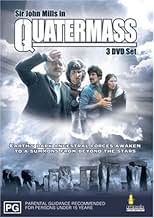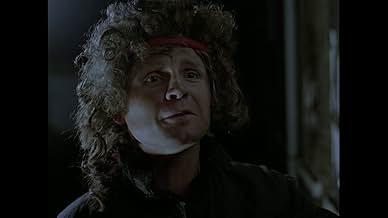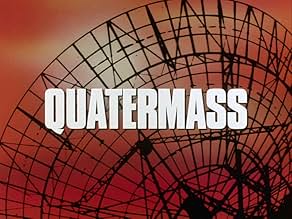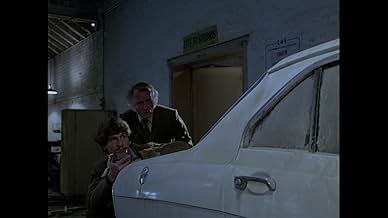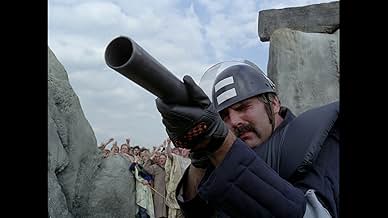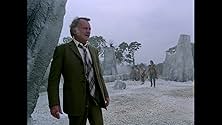Füge eine Handlung in deiner Sprache hinzuIn the distant future, a now-elderly Bernard Quatermass investigates the disappearance of his granddaughter and a mysterious cult.In the distant future, a now-elderly Bernard Quatermass investigates the disappearance of his granddaughter and a mysterious cult.In the distant future, a now-elderly Bernard Quatermass investigates the disappearance of his granddaughter and a mysterious cult.
Folgen durchsuchen
Empfohlene Bewertungen
The Quatermass Conclusion deals with an alien machine returning to the Earth after five thousand years to 'harvest' and stir-up the glandular secretions of humans which it then uses for it's own ends. Set in a near-future (in the 70s when it was released), the scene is an anarchistic, broken-down and violent vision of Britain, but none of the little touches are over the top enough to be classed as impossible. Prince Charles is on the throne, cars have number plates with 'v' on them and the Metropolitain Police are now privately contracted. Street crime, muggings and overall disorder are all the people know (oh no, it's all coming true!!) When the alien presence is identified as a threat rather than a religious saviour in a chilling Nigel Kneale trademark 'revelation of terror': the body parts in the ashes at Ringstone Round, Quatermass is employed in his quite usual role of leading science against politicians and the military machine to engage the menace. This seems to perk him up a little, when we see him first he is an old man broken down by the anarchy of society, depressed also that his work with the rocket group ended up being misused only for military ends. This is a very bleak piece which would depress viewers if it wasn't so busy chilling and terrifying the hell out if them with trademark Nigel Kneale 'terror revelations' and extremely succinct scientific concepts and valid predictions. Not only that, but it lays claim to having the most chilling and atmospherically terrifying aspect of all of the Quatermass films and serials, the spine-tingling refrain of 'huffity-puffity Ringstone Round'. I always only ever thought there were three Quatermass serials, Xperiment, II and Pit, up until about 4 years ago, when a conversation in a pub about there being another where 'people were being drawn to Stonehenge to be eaten' put me on the trail of this, and the first time I managed to get to see it after this revelation my blood ran cold at that nursery rhyme. I had a shudder just then recalling it.
This was Nigel Kneale's fourth and final Quatermass TV serial. The first three were also adapted into very good movies, this one wasn't, but it was edited down into a film, usually known as "The Quatermass Conclusion". I say avoid that and try and see this the full version, which goes for around 200 minutes. John Mills' Quatermass is very different from Andrew Keir's, Andre Morell's and most especially Brian Donlevy's Quatermass. Mills plays him as a tired and out of touch old man. The plot is set in the near future. Society has broken down, youth gangs roam the streets, while others known as "the planet people" wander the countryside. They are anti-science, anti-"progress" hippies who believe that they will one day be taken up and sent to another planet. I see some people criticise the planet people as being "out of date". These people seem to be unaware of the travellers/"crusties" phenomenon in Britain in the 1980s, and what about the "Heaven's Gate" cult of more recent years? Quatermass' granddaughter has run away from home, and while he searches for her he becomes involved with the planet people, a group of which seemingly are "taken" while congregating around some ancient standing stones. But this is only the beginning... to give away more of the plot would be a shame. The budget for this mini-series is obviously not all that large, and the special effects are modest, but they are generally pretty effective, the acting is good for the most part, and it contains an intelligence and darkness rarely seen in contemporary TV SF. 'Quatermass' has a few flaws but I think it is extremely underrated and a fine close to Kneale's Quatermass series.
I recently watched the complete four-hour version of Nigel Kneale's British miniseries "Quatermass." I had seen an edited movie version called "The Quatermass Conclusion" some years earlier. The verdict: The miniseries is superior. It expands on several subplots (of course) and offers richer characterizations. John Mills makes an excellent Quatermass--somewhat befuddled at the outset, but strong and clear of mind when the survival of the world is at stake. Granted, the production is not as polished as the movie version of "Quatermass and the Pit" (the music, in particular, sounds like it costs a couple of hundred bucks). But the ideas are intriguing and that darn nursery rhyme about Ringstone Round is still running around my brain. Kneale wrote a novelization of the miniseries that clarifies a few vague points.
"The Quatermass Conclusion" is one of the few 'true' pieces of science fiction ever committed to film and Nigel Neale's script rates up there with "2001" and "Dark Star" for inventiveness. Unfortunately it suffered from an obviously low budget and there are lapses here and there into melodrama. The story, set in a dystopian Britain, concerns the arrival of an unknown alien force which is 'harvesting' the youth by leading them to ancient ritual sites. Professor Quatermass (John Mills) comes out of retirement to look for his missing granddaughter and is drawn into the fight to save the planet's population. There are some disturbing images such as Wembley Stadium reduced to a 'killing ground' and the pensioners forced to live underground for safety. Many of the predictions in the film have since come about, such as the upsurge in 'hippy travellers' and the general social decay of the inner cities.
It is the near future. Britain struggles with the collapse of civilisation and violent bands of urban guerrillas rule. Also Earth is being harvested. Ancient sites of gathering all over the globe turn out to be the focal points of a blinding and powerful ray from outer space that leaves a pile of ash where thousands once stood. Various elements of Homo sapiens are essential to an anonymous alien race, and once again the time is, or rather we are, literally, ripe. It falls on the now retired Professor Bernard Quatermass, veteran of weird goings on long before Fox Mulder, to basically save the planet. Again.
The idea of a fourth Quatermass serial was kicked around the BBC for three years before being finally commissioned in 1971, and then later dropped by them as being too expensive. The production was picked up by Euston Films, Thames Television's TV film-making subsidiary (their most famous production at the time being the uncompromising and controversial police drama 'The Sweeney'). Euston increased the budget to £300,000 per episode with the criterion that the final product be produced in two versions: four fifty-minute episodes plus a single, shortened version for theatrical release and overseas markets in order to recoup some of their production costs. This created a writing dilemma for original creator and writer Nigel Kneale who now had to come up with two scripts for the same story. He neither wanted the theatrical release to be an edited version of the series, nor the series to be a padded out version of the film. Both had to work in their own right, and, thanks to Kneale's skill (he was an experienced screenwriter and at one time 'script doctor' for the BBC), they do. Unfortunately with the story having been written in 1972 and reflecting the political and economic concerns of that time, by the time it reached the screens in 1979, with it's new-age hippy type characters, it was already out of date (though it is still superior to the recent and dreadful '28 Days Later').
Euston also wanted a big name to play the lead, hence Sir John Mills, who is badly miscast and clearly looks as uneasy as he reportedly was with the role. Gone is the bombastic, resourceful yet flawed character played in the '50s BBC serials by Reginald Tate and brilliantly by Andre Morell, and later more famously by Andrew Keir in Hammer's 1967 'Quatermass and the Pit' (American actor Brian Donlevy had played the role in the first two Hammer Films but Kneale so hated him in the role he withheld permission to make a third Quatermass film for ten years). Here Mills plays him as a semi-senile, despairing, doddering tired old man. He is as much Quatermass as Peter Cushing was Dr. Who, but he fulfilled the need of the 'big name' at the time, being not only an already established British film dignitary and household name, but also then still familiar to TV audiences as having recently appeared in the popular 'Zoo Gang'. But it is hard to believe this is meant to be the same Quatermass we have seen in previous incarnations.
The plusses though are in the production values. At that time most British TV drama series tended to be controlled environment, studio bound affairs with the odd bit of grainy location footage (a la 'Dr. Who', 'Doomwatch' etc.) but 'Quatermass' was, strikingly for the time, shot entirely on location on 35mm Panavision, with great expense being laid out particularly on Joe Kapp's radar facility and home. It was also intended that Stonehenge would be one of the main locations. Permission to use it was however withdrawn by the British Tourist Board because it had become very popular with tourists and they didn't want anyone, or anything, even by inference (in the script several thousand people get fried simply by gathering there, so I suppose not a good selling point from their point of view), jeopardising their little earner.
Sci-Fi/Fantasy film and TV buffs will enjoy early appearances by Simon MacCorkindale, later of the short lived series 'Manimal'; Brian Croucher (the second 'Travis' in 'Blake's 7'); Declan Mullholland (the original, later CGI'd out, actor who played 'Jabba the Hutt' in 'Star Wars') as a TV Studio guard; David Yip, who would be Indie's ill-fated accomplice in the 'Club Obi-Wan' in the opening sequence of 'Indiana Jones and the Temple of Doom'; and, talking of Indie, a major role played by Margaret Tyzack, who would later become the young Indie's long-suffering Oxford tutor in 'The Young Indiana Jones Chronicles'. Also featured in an early role is Brenda Fricker, later to win an Oscar for Best Supporting Actress in 'My Left Foot'. Executive Producer Verity Lambert was already well known to fans of this genre for her involvement with 'Dr. Who' and 'The Avengers'.
If you are a Quatermass fan, a fan of British Sci-Fi, or even a budding screenwriter wanting to pick up a few tips, then this is an essential addition to your library. The set is nicely presented and is released to coincide with the 50th anniversary of the first broadcast of 'The Quatermass Experiment' in 1953. The package folds out to an 18" picture of (ironically) Stonehenge. The two discs containing the four episodes, simply called 'Quatermass', feature extensive production notes, animated menus, the opening and closing titles for each episode with each episode having a spectacular cliffhanger ending, making you eager to watch the next, and the hours pass swiftly. The third disc contains the theatrical version, retitled 'The Quatermass Conclusion', and a previously unseen Sci-Fi Channel interview with Nigel Kneale. Also enclosed is a booklet on the Quatermass history.
Overall it is an engrossing watch, but as Nigel Kneale himself says: "It was a product of its time."
The idea of a fourth Quatermass serial was kicked around the BBC for three years before being finally commissioned in 1971, and then later dropped by them as being too expensive. The production was picked up by Euston Films, Thames Television's TV film-making subsidiary (their most famous production at the time being the uncompromising and controversial police drama 'The Sweeney'). Euston increased the budget to £300,000 per episode with the criterion that the final product be produced in two versions: four fifty-minute episodes plus a single, shortened version for theatrical release and overseas markets in order to recoup some of their production costs. This created a writing dilemma for original creator and writer Nigel Kneale who now had to come up with two scripts for the same story. He neither wanted the theatrical release to be an edited version of the series, nor the series to be a padded out version of the film. Both had to work in their own right, and, thanks to Kneale's skill (he was an experienced screenwriter and at one time 'script doctor' for the BBC), they do. Unfortunately with the story having been written in 1972 and reflecting the political and economic concerns of that time, by the time it reached the screens in 1979, with it's new-age hippy type characters, it was already out of date (though it is still superior to the recent and dreadful '28 Days Later').
Euston also wanted a big name to play the lead, hence Sir John Mills, who is badly miscast and clearly looks as uneasy as he reportedly was with the role. Gone is the bombastic, resourceful yet flawed character played in the '50s BBC serials by Reginald Tate and brilliantly by Andre Morell, and later more famously by Andrew Keir in Hammer's 1967 'Quatermass and the Pit' (American actor Brian Donlevy had played the role in the first two Hammer Films but Kneale so hated him in the role he withheld permission to make a third Quatermass film for ten years). Here Mills plays him as a semi-senile, despairing, doddering tired old man. He is as much Quatermass as Peter Cushing was Dr. Who, but he fulfilled the need of the 'big name' at the time, being not only an already established British film dignitary and household name, but also then still familiar to TV audiences as having recently appeared in the popular 'Zoo Gang'. But it is hard to believe this is meant to be the same Quatermass we have seen in previous incarnations.
The plusses though are in the production values. At that time most British TV drama series tended to be controlled environment, studio bound affairs with the odd bit of grainy location footage (a la 'Dr. Who', 'Doomwatch' etc.) but 'Quatermass' was, strikingly for the time, shot entirely on location on 35mm Panavision, with great expense being laid out particularly on Joe Kapp's radar facility and home. It was also intended that Stonehenge would be one of the main locations. Permission to use it was however withdrawn by the British Tourist Board because it had become very popular with tourists and they didn't want anyone, or anything, even by inference (in the script several thousand people get fried simply by gathering there, so I suppose not a good selling point from their point of view), jeopardising their little earner.
Sci-Fi/Fantasy film and TV buffs will enjoy early appearances by Simon MacCorkindale, later of the short lived series 'Manimal'; Brian Croucher (the second 'Travis' in 'Blake's 7'); Declan Mullholland (the original, later CGI'd out, actor who played 'Jabba the Hutt' in 'Star Wars') as a TV Studio guard; David Yip, who would be Indie's ill-fated accomplice in the 'Club Obi-Wan' in the opening sequence of 'Indiana Jones and the Temple of Doom'; and, talking of Indie, a major role played by Margaret Tyzack, who would later become the young Indie's long-suffering Oxford tutor in 'The Young Indiana Jones Chronicles'. Also featured in an early role is Brenda Fricker, later to win an Oscar for Best Supporting Actress in 'My Left Foot'. Executive Producer Verity Lambert was already well known to fans of this genre for her involvement with 'Dr. Who' and 'The Avengers'.
If you are a Quatermass fan, a fan of British Sci-Fi, or even a budding screenwriter wanting to pick up a few tips, then this is an essential addition to your library. The set is nicely presented and is released to coincide with the 50th anniversary of the first broadcast of 'The Quatermass Experiment' in 1953. The package folds out to an 18" picture of (ironically) Stonehenge. The two discs containing the four episodes, simply called 'Quatermass', feature extensive production notes, animated menus, the opening and closing titles for each episode with each episode having a spectacular cliffhanger ending, making you eager to watch the next, and the hours pass swiftly. The third disc contains the theatrical version, retitled 'The Quatermass Conclusion', and a previously unseen Sci-Fi Channel interview with Nigel Kneale. Also enclosed is a booklet on the Quatermass history.
Overall it is an engrossing watch, but as Nigel Kneale himself says: "It was a product of its time."
Wusstest du schon
- WissenswertesStarted life in 1973 as a BBC series called "Quatermass IV". It had been commissioned by Head of Drama Ronald Marsh, and according to Nigel Kneale, the intended producer was Joe Waters. Some model test sequences of the space station were shot, but eventually, the project was abandoned by the BBC. ITV then picked it up a few years later and produced it in association with Euston Films.
- Alternative VersionenThis has been made available in the United States in two versions. It was first released edited down to a 105 minute feature film under the title The Quatermass Conclusion (1979). In 2003 the complete program was released on home video under the title "Quatermass" with a listed running time of 240 minutes.
- VerbindungenEdited into The Quatermass Conclusion (1979)
Top-Auswahl
Melde dich zum Bewerten an und greife auf die Watchlist für personalisierte Empfehlungen zu.
- How many seasons does Quatermass have?Powered by Alexa
Details
Zu dieser Seite beitragen
Bearbeitung vorschlagen oder fehlenden Inhalt hinzufügen

